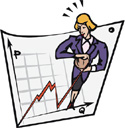The Business Cycle
Part 1: In General One word that seems to be bandied about every few years is recession. Many people shudder when they hear the word recession. It's certainly not a good thing if you're a business owner. But a recession is just part of an overall pattern that economists call the business cycle. The use of the word cycle suggests that things happen again and again, every so often. That is definitely true. A common definition of a business cycle in American economics has the following four stages:
Let's look at each term in turn.
A peak is usually identified after it happens because this is the time when a country's expansion is at its highest level. Economists don't really know when the expansion is going to peak, so they wait until production and hiring start to fall, then identify the peak. A contraction is the reverse of an expansion. During a contraction, production goes down, hiring goes down, and people are generally less happy than they are during an expansion. A country's output commonly decreases during a contraction, as does consumer confidence.
If a recession lasts a particularly long time and gets progressively worse, economists might call it a depression. Economically, things are really bad during a depression. A prime example of this in American history was the Great Depression, which lasted more than a decade and resulted in thousands of people losing their jobs and their life savings. A trough is the opposite of a peak. A trough is the low point of an economy. As they do with a peak, economists will identify a trough only after the fact, when productivity begins to head upward again and the low point can be calculated. The next phase of the business cycle after a trough is expansion. Thus, the cycle resets itself. |
|
Social Studies for Kids
copyright 2002–2024
David White



 An expansion is a time when businesses are expanding, producing more goods and hiring more workers. This is generally a happy time for people because it usually means that more money is coming into the economy and that people and businesses are able to afford more things than they normally might be.
An expansion is a time when businesses are expanding, producing more goods and hiring more workers. This is generally a happy time for people because it usually means that more money is coming into the economy and that people and businesses are able to afford more things than they normally might be.  A particularly long contraction can be termed the dreaded recession. During a recession, businesses are slumping, companies are laying off workers, and consumers are generally grumbling.
A particularly long contraction can be termed the dreaded recession. During a recession, businesses are slumping, companies are laying off workers, and consumers are generally grumbling.
